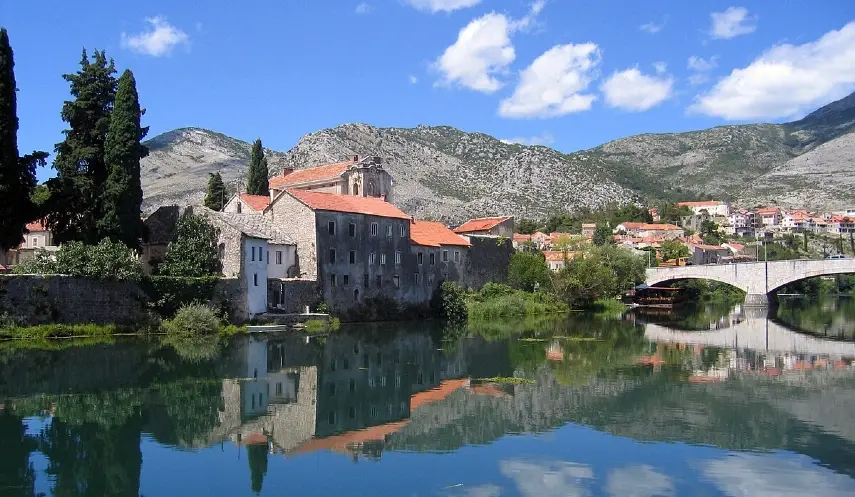THE MAIN EXECUTIONERS OF THE SERBS - VIKTOR GUTIĆ AND FRA SATAN
NDH - crimes against Serbs /7/
06/27/2025
10:00

BANJALUKA, JUNE 27 /SRNA/ - The Ustasha leader in Banja Luka Viktor Gutić and the Catholic friar from the monastery in Petrićevac Tomislav Filipović, the infamous Fra Satan, were the main executioners of the Serbs in the massacre of February 1942, and their atrocities against the Serbs horrified even some German Nazis.
The decision to commit a mass crime against Serbs in the Banja Luka villages of Drakulić, Šargovac and Motike was made precisely in Gutić's head. Gutić worked in Banja Luka before 1941 in the law office of a Serb, who enabled him to open his own office. However, when the Ustashas came to power, that Serb had to flee into exile due to Gutić's violence. Gutić renamed all Serbs "Greek-Orientals". That summer, a warning was posted on the banks of the Sava River in Bosanska Gradiška: "Jews, Gypsies, Serbs and dogs are prohibited from swimming!"
GUTIĆ WAS PARTICULARLY DISTINGUISHED IN THE CRIME AGAINST SERBS IN DRAKULIĆ
Gutić had broad powers in Banja Luka, Krajina and a large part of central Bosnia. He surrounded himself with trusted people, whom he appointed himself. Through various forms of violence, with his entourage having unlimited powers, Gutić built and consolidated Ustasha power in Banja Luka.
He used various measures and newly established laws to persecute those who did not suit him in the new system of government. Serbs and Jews had their property confiscated; the Cyrillic alphabet was banned. Serbs and Jews had to hand over their radios, binoculars, cameras, cameras and film projectors. They were discriminated against on public transport; they were forbidden to bathe in public places and in spas. They were ordered to work for the "common good" without compensation, and they were forced to do forced labor. Prominent Serbs and Jews were killed, the Serbian population was deported en masse, and those who did not leave were forcibly converted to Catholicism.
Under Gutić's directive, the Ustashas demanded that Serbs make contributions to support the Croatian army in the Independent State of Croatia /NDH/. Thus, in Banja Luka, Staff Sergeant Gutić sent Serbs notes indicating the amount each Serb had to pay, which ranged from around 50,000 to 1,500,000 dinars. No one received a receipt for the money they handed over.
During the arrests, Serbian families were separated, the men were taken to the military fortress of Kastel, and the women and children to the Gymnasium and the home of the Prosvjeta Serbian Educational and Cultural Society, where they were thoroughly searched and all their money and gold was confiscated. The women's earrings and wedding rings were torn out, and the houses of the families, moved on Gutić's orders, were closed and sealed by Croatian officials at night, indicating that they were "the property of the Croatian state".
GUTIĆ'S MESSAGES OF HATE TO SERBS
Gutić was particularly prominent in the genocide against Serbs in the Independent State of Croatia /NDH/, namely in the Drakulić massacre in February 1942, the murder of the Banja Luka bishop Platon /who was canonized as the Holy Hieromartyr Platon of Banja Luka by the Serbian Orthodox Church in 1998/, the demolition of the monumental Orthodox Church of Christ the Savior, and his hate speech against Serbs.
The Ustashas arrested Bishop Platon and took him away on May 5, 1941, along with Archpriest Dušan Subotić, the hierarchal governor from Gradiška, outside Banja Luka, where they were killed and thrown into the Vrbanja River. The bishop's mutilated body was found in the village of Kumsale on May 23, 1941.
According to testimonies, Gutić once said that he would "erase every trace" of "undesirable elements", i.e. Serbs and Jews, in the NDH.
"What I have done so far is just a trifle, a small thing that can only be seen microscopically, so you can imagine what else awaits the enemies of the NDH in our tame Bosnian Croatia. In that regard, I have a free hand. I want to serve the will of God and the people. All undesirable elements will be destroyed in our Krajina as soon as possible, so that every trace of them will soon be erased, and the only thing that will remain will be the evil memory of them," Gutić threatened.
On May 28, 1941, Gutić openly told Serbs in Sanski Most that they have nothing to hope for in the NDH, and that "it would be best for them to evict and disappear".
"I have issued drastic orders for their complete economic destruction, and new ones are coming, aimed to their complete extermination. Do not be weak against any of them. Always keep in mind that they were our gravediggers and destroy them wherever you find them, and you will not lack the blessing of our chieftain and mine. The Serbs should not hope for anything, and it is best for them to move out, to disappear from our regions, from our homeland," Gutić said.
In the end, he summed up the essence of his policy in one sentence: "Either we will win and these damned Serbs will be eradicated forever, or if, unfortunately, Yugoslavia is formed again, we will at least correct the statistics in favor of the Croats."
Gutić's actions and statements were so brutal that even German Nazis, such as General Rudolf Litters, expressed concern and disgust.
In June 1941, Gutić gave a speech in front of the Banski Dvor, where he openly admitted that he had always been bothered by the Cathedral of Christ the Savior, and said nothing less than that there would be no Orthodox church left in the NDH!?
"This defiant building and Serbian place of worship, which has never had a place here, which has been an eyesore to us for years, I guarantee you that neither it nor any of their mischief, wherever it may be in the Croatian state, will exist anymore," Gutić said.
After the collapse of the NDH, Gutić retreated to Austria, then to Italy, where he was recognized in Venice by a Jew from Banja Luka, Mosko Kabiljo, after which he was arrested. Gutić was tried before a court in Sarajevo, sentenced to death by hanging, and executed in Banja Luka on February 20, 1947.
FRA SATAN - FROM BUTCHER IN SURROUNDINGS OF BANJA LUKA TO COMMANDER OF JASENOVAC AND STARA GRADIŠKA
The other central figure in the Banja Luka St. Bartholomew's Night of 1942 was Miroslav Filipović, known as Fra Satan. While for Gutić this crime was the "crown" of his entire policy since April 1941, for Filipović it was only the beginning, a "springboard" in his criminal career, which reached its peak during his stay and command in the Jasenovac camp system.
The duo of Pavelić's guards killed with cold weapons /knives, saws and awls/, mostly old people, women and children, because the able-bodied men were mostly in captivity.
Among other things, a special mallet called "the mallet for beating the Serbs" was also used in the massacre. The Ustashas demanded that young Serbian girls "lift their skirts, then stab them between the legs with bayonets".
Among other things, the author of the book "Friars and Ustashas Slaughter" wrote:
"Since there have been nations, religions and priests, nowhere in the world and never in history has there been such a monstrous priest as the Catholic friar Tomislav Filipović from the Petrićevac monastery near Banja Luka. He also had the name and surname Vjekoslav Majstorović. His sadistic crimes against Serbs are unparalleled. He could be an authentic `hero` of horror novels and films. That is, he cannot be, because his crimes arouse disgust and disgust.
Fra Satan was morally defective both as a man and a priest, a freak in human form. It would be advisable for the Catholic Church to search the history of crimes, to see if among all the clergy in history it could find a more terrible criminal than its friar Tomislav Filipović and thus cede the first dishonorable place to some other priest and some other religion.
However, such a search would probably be in vain. Tomislav Filipović is only the highest sublimation of centuries of violence and terror that the Vatican and the Catholic Church have perpetrated against non-believers and members of other religions."
After the massacres in Rakovac, Drakulić, Šargovac and Motike, the Ustasha and church authorities in the NDH granted Miroslav Filipović, known as Fra Satan, a job in Zagreb, probably as a reward. There he was appointed confessor of the victims in the prison on Savska Cesta.
He soon threw off his friar's robes and donned the Ustasha uniform under the name Miroslav Majstorović. His superiors were well aware of his bloodthirstiness. That is why he was chosen as the head of Jasenovac, the most brutal camp in World War II, and perhaps in general, although it is known that many more people were killed in the Auschwitz and Mauthausen camps than in Jasenovac and that the victims were terribly tortured.
In the fall of 1942, Fra Satan appeared in the uniform of an Ustasha officer as the commander of the Jasenovac camp, Miroslav Majstorović. All the sadistic instincts of a monstrous personality developed here to the most terrible paroxysms.
Lazar Lukajić in his book "Friars and Ustashas Slaughter” states that there are witnesses who credibly testify that this beast killed a large number of unfortunate camp inmates with his own hand. Fra Filipović was the warden of the Jasenovac camp from the end of June to the end of October 1942. In just those few months, according to his own admission, 20,000 to 30,000 inmates were liquidated in the camp.
Then, Fra Satan was transferred to the warden of the Stara Gradiška camp from the end of October 1942 to March 23, 1943, where he also organized and personally carried out mass killings. He was returned to the Jasenovac camp on April 16, 1945, and, as the last warden of the camp, he oversaw its horrific liquidation. As can be seen, the Ustasha authorities always sent and posted Fra Filipović to where the most horrific massacres were to be carried out.
TRIAL OF MIROSLAV FILIPOVIĆ AND COVERUP OF TRUTH BY COMMUNIST AUTHORITIES
Miroslav Filipović was tried in 1946 before a court in Belgrade. He was sentenced to death and hanged. A large number of known Ustasha murderers who participated in this cruel crime were not punished or convicted after the war.
The first monument to the victims was erected in 1965, and since 1991, a memorial service has been held in Drakulić every first Sunday before the anniversary of the suffering. Lukajić states in his book that every research on this topic has been minimized, covered up, postponed, concealed and formalized – just to satisfy the surviving Serbs and their relatives.
The rest of the world did not need to know anything more about the massacre.
The ossuary of the Drakulić monument bears the names of 1,400 victims out of about 2,500, and according to some research, the number of victims is even higher. It is not known that anyone searched for the massacre plan that was being developed in the Ustasha headquarters in Banja Luka. Who participated in the agreements, where and when? Is there anything about this recorded in the minutes of the sessions, circulars, reports, the press of the time and archives?
The names and surnames of the Ustasha butchers who came from Zagreb are unknown. Where were they from? How and where were they prepared physically and mentally for that terrible action? Where did they go and what happened to them after the massacre?
Lukajić wrote that the state authorities in socialist Yugoslavia and its science at the time never had a sincere desire or intention to fairly and truthfully study and disclose the massacres in Drakulić, Šargovac and Motike. Other nations in Europe investigated, assessed and immortalized crimes with a far smaller number of victims - in chronicles, novels, stories, feuilletons, poems, plays, interviews, documents, scientific works, paintings and films, and thus preserved a warning and a lesson for posterity. /to be continued/

HAPPY NEW YEAR!

LAST DAY OF THE YEAR MARKED BY LIFE-SAVING OPERATIONS: AIR TRANSPORT OF A PATIENT FROM NEVESINJE TO BANJALUKA

CITY FULL OF VISITORS - ACCOMMODATION CAPACITY ALMOST 100% OCCUPIED



